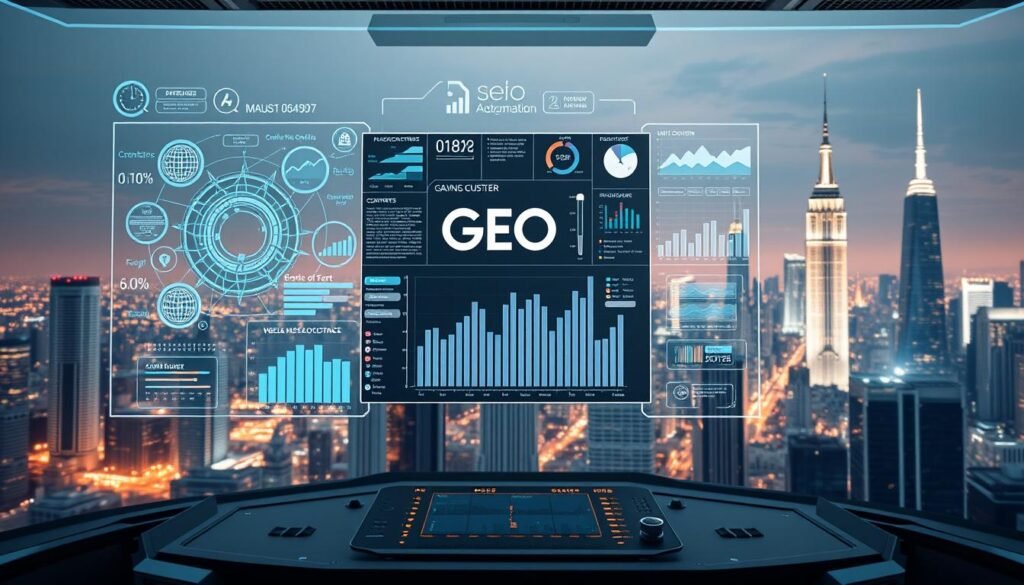Can your content still win when AI gives answers before anyone clicks?
Generative engine optimization changes how you plan content for modern search engines and AI assistants. You’ll learn why the debate isn’t about choosing GEO or SEO, but about combining both to protect your visibility as engines shift toward direct answers.
Users now ask longer, conversational queries and expect instant answers from tools like ChatGPT, Gemini, and other assistants. That means your information must be clear, structured, and credible to earn citations inside AI-generated responses.
We’ll define the new rules and show practical strategies you can use in 2025. Expect guidance on structure, authority, and clarity so your brand becomes a trusted source for both search and AI outputs.
Key Takeaways
- You don’t pick GEO or SEO — you blend tactics to keep reach and influence.
- Structured, fresh content improves chances of being quoted by AI assistants.
- Adjust planning so information is discoverable in search and quotable in answers.
- Focus on authority signals, clear formatting, and user-first clarity.
- By the end, you’ll have practical strategies to boost visibility where users look.
The search shift in 2025: From ranked links to AI-generated answers

Search has become assistant-first. In 2025, search engines push synthesized replies before traditional result pages appear. That changes how your content gets discovered and cited.
You now face longer, context-rich queries and deeper sessions. Answers arrive as summaries that pull from many sources, so relying only on rankings limits reach.
That means you must design content for extraction: clear snippets, concise facts, and structured blocks that assistants can quote.
AI overviews are increasing zero-click behavior, so front-loading useful details helps your brand get named even when clicks fall.
- Expect fragmented discovery across multiple engines and platforms.
- Prioritize clarity and portability so content travels well.
- Measure presence in assistant answers as much as classic traffic and CTR.
| Shift | Impact on content | Action |
|---|---|---|
| AI summaries first | Fewer ranked clicks; more citations | Structure facts for extraction |
| Longer queries | Deeper sessions; more context | Write conversational, precise passages |
| Fragmented discovery | Traffic shifts across platforms | Keep consistent, portable content |
Defining the contenders: Traditional SEO vs. Generative Engine Optimization
Two different goals now compete for the same attention. One system aims to rank pages in search engines like Google and Bing using keywords, backlinks, and technical health. The other aims to make your content extractable and citation-ready for AI assistants.
What traditional optimization does: It focuses on crawling, indexing, and ranking. That means keyword mapping, link authority, fast pages, and quality content to win search results and organic traffic.
What generative engine optimization does: It optimizes for ingestion and knowledge extraction. You craft short, verifiable facts, clear headings, and labeled data so models can quote you in answers.

In 2025, longer queries and multimodal replies make extractability and trustworthiness as important as ranking.
- You’ll separate goals: ranking in search engines vs. earning citations inside AI answers.
- Traditional search rewards keyword strategy and backlinks; the new layer rewards clarity and authority.
- Both approaches must work together: keep technical health while shaping content for model parsing.
GEO or SEO: Which should you focus on for visibility today?
Many search sessions now end with a quick summary delivered by an AI, not a visit to your site.
Decide by your goals: if you need steady, measurable traffic and a strong SERP footprint, prioritize traditional optimization tactics. These still win clicks on major search engines and build a predictable pipeline to your website.
When to prioritize search rankings and site traffic
Focus on ranking when your KPI is measurable growth — organic traffic, keyword positions, and CTR. Use keyword mapping, backlinks, fast UX, and clear on-page content to capture high-intent users.
- Goal: predictable visits and conversions.
- Use: technical audits, on-page optimization, and analytics.
- Outcome: a stronger SERP presence for your website.
When to prioritize inclusion in AI answers and citations
Lean into making facts extractable when you need brand citations and presence inside assistant responses.
- Goal: higher citation frequency and model relevance across engines.
- Use: structured data, FAQs, short verifiable statements, and clear entity signals.
- Outcome: awareness and influence even when users don’t click through.
Balance both: launch content that is both rank-worthy and citation-ready. Use insights from each channel to close gaps between traffic and mentions.
Under the hood: How SEO and GEO actually work
To see how visibility actually forms, trace two separate pipelines that move content from your site into answers and ranked listings.
SEO pipeline: crawl, index, rank
You want your website discovered by search engines. Crawlers fetch pages, index useful data, and score pages for ranking.
Key signals: keywords in headings, backlink quality and quantity, page speed, mobile friendliness, and content quality. Clean technical foundations and strong user experience help crawlers index faster and users stay engaged.
How generative engines ingest and answer
Generative systems ingest large swaths of content and extract facts, entities, and relationships from data. They then assess relevance and synthesize a response.
Clarity, labeled sections, and unique insights increase the chance your text is selected as a citation inside an answer.
Shared signals that matter:
- E‑E‑A‑T and corroborating sources raise authority for both ranking algorithms and inclusion logic.
- Freshness and update cadence keep your content relevant to new queries.
- Structured data, FAQs, and clear headings make extraction and indexing reliable.
“Structure content so both crawlers and models can find clean facts; that alignment boosts rankings and citations.”
| Pipeline | Core steps | Top signals |
|---|---|---|
| Search engine crawl | Crawl → Index → Rank | Keywords, backlinks, speed |
| Generative engine ingestion | Ingest → Extract → Assess → Generate | Clarity, entities, labeled facts |
| Shared | Discovery → Trust → Delivery | E‑E‑A‑T, freshness, structured data |
Results, traffic, and measurement: Rankings versus references
Your dashboards must show not just traffic but how often models cite your pages.
Track two complementary scorecards: one for classic performance and one for mention-level visibility inside assistant outputs.
SEO KPIs you track
Benchmark organic traffic, ranked terms, CTR, and on-site conversions to quantify demand capture.
Also watch bounce rate and session duration as signals of content relevance to users.
GEO KPIs you monitor
Measure citation frequency, inclusion in AI responses, accuracy, sentiment, and share of voice.
Use platforms like Profound, Goodie, Daydream, Writesonic, and Ahrefs Brand Radar to see which sources shape answers.
“Reference rate becomes a visibility proxy when zero-click patterns rise; impressions alone no longer tell the whole story.”
Bring data together. Reconcile falling clicks with stable or rising impressions by reporting visibility across search results and synthesized answers.
- Combine traffic and mention metrics to align stakeholders on dual goals.
- Add accuracy and sentiment checks so models present your information correctly and positively.
- Use insights to attribute influence across the pipeline, not just last-click conversions.
| Metric set | Primary signals | Why it matters |
|---|---|---|
| Classic results | Organic traffic, rankings, CTR, conversions | Shows demand capture and site performance |
| Reference metrics | Citation frequency, inclusion rate, accuracy, sentiment | Shows presence inside assistant answers and brand reach |
| Combined view | Impressions, mentions, engagement, attribution | Connects visibility to business outcomes |
Your 2025 playbook: Strategies to win across search engines and AI engines
Build your playbook around extractable facts that travel well into assistants and result pages.
Answer-first content structure helps both users and models find the right fact quickly.
Answer-first content structure: clear headings, lists, and extractable statements
Use short headings and bulleted lists so a snippet can be copied without loss. Start sections with the one-line answer, then expand with context.
Schema and structured data: FAQs, how-tos, and entity clarity for better parsing
Add FAQ and HowTo schema so engines and generative engine systems parse intent and entities reliably. Label dates, authors, and definitions to reduce ambiguity.
Authority building: expert bylines, original research, reputable sources, and links
Show your work. Publish author bios, cite reputable sources, and surface original research. These signals raise trust for both ranking and citation.
Design for zero-click and AI summaries: front-load facts and context-rich language
Front-load the fact, then add one clear sentence of context. Use simple language that balances keyword relevance with meaning-dense phrasing.
“Depth wins: comprehensive pages rank in search engines and supply extraction-ready material for assistants.”
- Structure content with dual-purpose headers that aid readability and reference checks.
- Use schema to make relationships and entities explicit for parsing tools.
- Refine UX—scannable typography, concise media, and tested snippets—to boost user experience and inclusion rates.
Use tools to find citation gaps, iterate fast, and keep quality high across your website.
Tools and workflows: Integrating traditional SEO and GEO operations
A practical workflow pairs traditional auditing tools with platforms that monitor mentions inside AI answers.
Start by running a dual stack: keep classic tools that protect crawling, rankings, and site health while adding specialized platforms that track which sources feed model answers.
Traditional stack
Use Google Search Console for indexing and error checks. Add Ahrefs and Semrush for keywords, backlinks, and competitor data.
Schedule technical audits for crawlability, sitemaps, speed, and mobile issues so your website stays accessible to search engines like Google.
Visibility platforms for model references
Use Writesonic to track citations and sentiment, and Profound, Goodie, and Daydream to map share of voice inside AI Overviews.
Complement these with Ahrefs Brand Radar and Semrush AI toolkits to monitor which publishers shape synthesized answers.
Operational loop
Track references, find gaps, optimize, and iterate fast.
- Monitor where engines cite competitors but miss your pages.
- Aggregate insights across sources to find publishers that influence answers.
- Update pages: add structured facts, FAQs, schema, and clearer headings.
- Test prompts and synthetic queries to mirror how users ask questions.
- Keep a weekly cadence for refreshes aligned to model and search engine updates.
“Connect marketing ops to a repeatable loop: detect citation gaps, add structure, and recheck inclusion—fast.”
Conclusion
Combine steady fundamentals with answer-first thinking to protect long-term visibility.
Start practical: pick one high-performing page on your website and make it extraction-ready. Add clear entities, short facts, FAQ schema, and reputable links. Measure whether assistants cite that page, then iterate.
Over time, scale what works. Keep improving structure, quality, and language so engines and users find your information easily. Track both traffic and mentions to show real impact to stakeholders.
In short, blend traditional search foundations with citation-ready tactics. That dual approach future-proofs your brand so you appear in ranked lists and in synthesized answers users see today.



